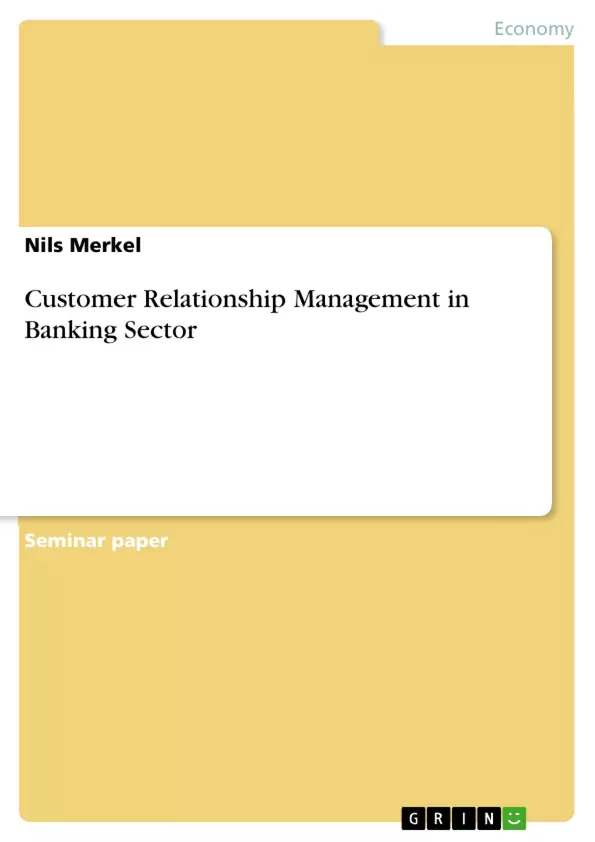According to the changing of the general conditions the German banks are forced to break new ground in order to assert their position: The market became much more lucent for customer because of new media.
The consequences are an increasing pressure of competition and demanding cus-tomer. Therefore a binding and long-term customer relationship seems to be neces-sary for many banks to react to the changed conditions and to guarantee the continu-ity. A majority of German credit institutions tried to implement concepts of Customer Relationship Management (CRM). In some cases the afford - to turn the customer re-lationship into the road to success - were unsatisfying and unsuccessful.
In this paper I want to show, how CRM works, how CRM can be implemented in banks and what problems can result from the implementation.
In the first chapter I describe the current situation of German banks. After a brief overview about CRM in general we analyze the previous attempts of CRM implemen-tation. Two examples - Dresdner Bank and Deutsche Leasing, a member of the "Sparkassen - Finanzgruppe" - follow. At the end I identify the problems of the im-plementation of CRM at the banks.
Table of Contents
- General survey of the German banks
- Customer Relationship Management
- Definition
- Systematization of CRM
- Analytical CRM
- Operational CRM
- Collaborative CRM
- CRM in banking sector
- Expectations from companies in the banking sector
- Requirements of a successful implementation
- Analytical CRM: Determination of the target group
- Maesurement of the success of CRM in the banking sector
- Example of Dresdner Bank
- Departments where CRM was implemented
- Goals of the CRM implementation
- Realization of the CRM project
- Benefits gained
- What made this CRM project special?
- Example of Deutsche Leasing
- What was implemented?
- Results of implementation
- Problem of implementation
Objectives and Key Themes
This paper examines the role of Customer Relationship Management (CRM) in the German banking sector. It focuses on how CRM works, its implementation in banks, and the potential problems arising from its implementation. The paper explores the changing landscape of the German banking market and the rising pressure on banks to adapt to new customer demands and competition.
- The evolving nature of the German banking sector and the impact of competition
- The importance of Customer Relationship Management (CRM) in the banking sector
- The different aspects of CRM, including analytical, operational, and collaborative approaches
- The implementation of CRM in banking institutions, using examples such as Dresdner Bank and Deutsche Leasing
- The challenges and potential problems associated with the implementation of CRM in banks
Chapter Summaries
The first chapter provides an overview of the current situation in the German banking sector. It highlights the fragmented nature of the market, the increasing cost pressure, and the need for consolidation to enhance competitiveness. The chapter further examines the evolving demand behavior of customers, emphasizing the growing importance of investment opportunities and the impact of the European Basel guidelines on banks' capital requirements and credit investigations.
Chapter 2 defines CRM and its various dimensions, namely analytical, operational, and collaborative CRM. This chapter lays the groundwork for understanding the concept and its potential applications in the banking sector.
Chapter 3 explores the expectations and requirements for successful CRM implementation in the banking sector. It delves into the analytical aspects of CRM, including target group determination, and methods for measuring the success of CRM initiatives. This chapter also presents case studies of Dresdner Bank and Deutsche Leasing, highlighting the implementation details, goals, benefits, and unique aspects of their respective CRM projects.
The final chapter focuses on the problems encountered during the implementation of CRM in banks, offering valuable insights into the challenges faced by these institutions.
Keywords
The key focus areas of this paper are Customer Relationship Management (CRM), German banking sector, competition, customer demands, implementation challenges, analytical CRM, operational CRM, collaborative CRM, Dresdner Bank, Deutsche Leasing, and the changing landscape of the banking market.
- Citar trabajo
- Nils Merkel (Autor), 2005, Customer Relationship Management in Banking Sector, Múnich, GRIN Verlag, https://www.grin.com/document/58251



